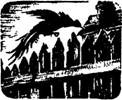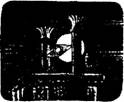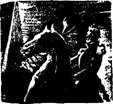Would you like
to download a copy of this book/website to read offline? Click Here to download the printable PDF version |
Bartending Home
01. Aperitif
02. Birth of Cocktail
03. Whiskey Drinks
04. Juleps
05. Absinthe Drinks
06. Gin Drinks
07. Rum Drinks
08. Pousse Cafes
09. Brandy Drinks
10. Cafe Brulot
11. Flips
12. Slings
13. Swizzle
14. Punches
15. Wassail Bowl
16. Eggsnogs
17. White Ribbon Punch
18. The Contradiction
Resources
Add URL
Privacy Policy
Contact us
3. Whiskey Drinks |
|
|
Whiskey is a potent drink and whiskey is a potent word—perhaps because both are of Irish extraction. The English pronunciation of the word in use today is based upon a word the ancient Gaels applied to the product of their stills, for it appears they were the original whiskey-makers.
The name they gave the distilled spirit was singularly fitting—they called it uisgebeatha. If we dissect the word we find that uisge (pronounced oosh'gee) means "water," hcatha moans "life," and the two combined menn "water of life." All of which goes to prove you can't beat the Irish for apt naming. In time this potent product of Ould Ireland's stills became "whiskbae," later "whiskie," and finally just plain "whiskey."
The Scots likewise were distillers of this ancient and honorable liquid. They adopted the original name the Irish gave to the white spirit which flowed from their stills, the word going through a similar sequence of pronunciation until it became "whisky" without the 'e"—note spelling on any bottle of Scotch.
We have much for which to thank the Irish, but whiskey rates a top place on the list. A toast to the Irish! And what drink may better serve such purpose than one of the many whiskey cocktails mixed to perfection as in New Orleans? Make it an Old Fashioned, a Sazerac, a Manhattan, a julep, a highball, or just plain whiskey. Whichever it may be, fill 'em up and drink 'em down to the original whiskey-makers —the Irish!
"Whiskee—Po! Give me a Glass of that Rhenish!" 1753
Highballs
1 jigger rye, whiskey,
or,
Bourbon whiskey,
Scotch whisky,
Irish whiskey,
cognac brandy,
applejack,
gin,
rum.
fizz water ice
The dictionary lowdown on highball: "a long drink of diluted spirits, usually whiskey, served in a tall glass with cracked ice."
Like all popular drinks, the highball is conspicuous for its variety. Any spirituous liquor will answer— it depends upon individual preference. Some like rye with seltzer water, some Bourbon; others hold that the spirit of the drink should be Scots whisky, and still others demand Irish whiskey. Brandy, rum, applejack, all have their advocates, and there are even benighted souls who crave gin in their highballs.
As they used to say out West: "Name your own poison, gents!"
For the fizz accompaniment use whichever of these appeals to you—seltzer, club soda, white rock, ginger ale, coca cola, seven-up. Connoisseurs, as a rule, insist that only cold water be poured upon their whiskey.
 |
The Sazerac Cocktail
Oldtimers will tell you the three outstanding drinks of New Orleans in the memory of living men were the dripped absinthe frappS of the Old Absinthe House, the Ramos gin fizz, and the Sazerac cocktail.
As previously related, the American cocktail was not only born in Old New Orleans but was given its curious name in the city's famous Vieux Carr6. There are cocktails and cocktails but the best known of all New Orleans cocktails is unquestionably the Sazerac. The fact that it originated in New Orleans gave rise to the legend that it was first concocted by and named for an old Louisiana family, legend without fact as no such Louisiana family ever existed.
A barbershop now holds forth in a building on the right hand side of the first block in Royal street going down from Canal, and before its doors, there still remains lettered in the sidewalk the word "SAZERAC." This denotation indicated the entrance-way to a once well-patronized bar on the Exchange Alley side of the building. It was here the drink famed far and wide as a Sazerac cocktail was mixed and dispensed. It was here it was christened with the name it now bears.
For years one of the favorite brands of cognac imported into New Orleans was a brand manufactured by the firm of Sazerac-de-Forge et fils, of Limoges, France. The local agent for this firm was John B. Schiller. In 1859 Schiller opened a liquid dispensary at 13 Exchange Alley, naming it "Sazerac Coffeehouse" after the brand of cognac served exclusively at his bar.
Schiller's brandy cocktails became the drink of the day and his business flourished, surviving even the War Between the States. In 1870 Thomas H. Handy, his bookkeeper, succeeded as proprietor and changed the name to "Sazerac House." An alteration in the mixture also took place. Peychaud's bitters was still used to add the right fillip, but American rye whiskey was substituted for the cognac to please the tastes of Americans who preferred "red likker" to any pale-faced brandy.
Thus brandy vanished from the Sazerac cocktail to be replaced by whiskey (Handy always used Maryland Club rye, if you are interested in brand names), and the dash of absinthe was added. Precisely when whiskey replaced brandy and the dash of absinthe added are moot questions. The absinthe innovation has been credited to Leon Lamothe who in 1858 was a bartender for Emile Seignouret, Charles Cavaroc & Co., a wine importing firm located in the old Seignouret mansion still standing at 520 Royal street. More likely it was about 1870, when Lamothe was employed at Pina's restaurant in Burgundy street that he experimented with absinthe and made the Sazerac what it is today.
But this history delving is dry stuff, so let's sample a genuine Sazerac. We will ask Leon Dupont, now vice-president of the St. Regis Restaurant but for years one of the expert cocktail mixers behind Tom Handy's original Sazerac bar, to make one for us.
Here's how—and how!
1 lump sugar
3 drops Peychaud's bitters
1 dash Angostura bitters
1 jigger rye whiskey
1 dash absinthe substitute
1 slice lemon peel
To mix a Sazerac requires two heavy-bottomed,3 ½ ounce bar glasses. One is filled with cracked ice and allowed to chill. In the other a lump of sugar is placed with just enough water to moisten it. The saturated loaf of sugar is then crushed with a barspoon. Add a few drops of Peychaud's bitters, a dash of Angostura, a jigger of rye whiskey, for while Bourbon may do for a julep it just won't do for a real Sazerac. To the glass containing sugar, bitters, and rye add several lumps of ice and stir. Never use a shaker! Empty the first of its ice, dash in several drops of absinthe, twirl the glass and shake out the absinthe . . . enough will cling to the glass to give the needed flavor. Strain into this glass the whiskey mixture, twist a piece of lemon peel over it for the needed zest of that small drop of oil thus extracted from the peel, but do not commit the sacrilege of dropping the peel into the drink. Some bartenders put a cherry in a Sazerac; very pretty but not necessary.
M-m-m-m! Let's have another, Leon!
Kentucky Whiskey Cocktail
1 jigger Bourbon whiskey
1 jigger unsweetened pineapple juice
1 lump sugar
Dissolve the sugar in the pineapple juice. Pour in the jigger of Bourbon. Then some lumps of ice. Stir. Strain in serving glass.
This cocktail could be made with rye whiskey, but then you'd not be privileged to attach the name Kentucky to it. Some make the same drink with orange juice instead of pineapple, and some use sweetened pineapple juice. If the latter, be wary of the amount of sugar you use.
Old Fashioned Cocktail
1 lump sugar
2 dashes Peychaud or Angostura bitters
1 jigger rye whiskey
1 piece lemon peel
1 chunk pineapple
1 slice orange peel
2 maraschino cherries
Into a heavy-bottomed barglass drop a lump of sugar, dash on the bitters, and crush with a spoon. Pour in the jigger of rye whiskey and stir with several lumps of ice. No shaking allowed! Let the mixture remain in the glass in which it is prepared. Garnish with a half-ring of orange peel, add the chunk of pineapple, and the cherries with a little of the maraschino juice. Twist the slice of lemon peel over all and serve in the mixing glass with the barspoon.
Old Fashioned? Yea, verily, but as appealing to smart tastes now as on that certain Derby Day a halfcentury ago when the originator, whoever he mayhave been, first stirred it into being at the Pendennis Club, in Louisville, Kentucky.
The Old Fashioned has been a New Orleans institution for many years and when other whiskey mixtures, garnished with fancy names, have passed on and been forgotten, the Old Fashioned will continue to tickle experienced palates. Don't let anyone tell you that gin, rum, or brandy can take the place of whiskey in an Old Fashioned. Turn a deaf ear to such heresy. A real Old Fashioned demands rye whiskey. Remember, Bourbon won't do.
In the old days before the Great Mistake the Old Fashioned contained less fruit than it does today. Howbeit, the expert barkeep of pre-prohibition days never neglected to twist a slice of lemon peel over the glass before serving.
Blue Blazer
1 lump sugar
1 jigger Scotch whisky
1 jigger hot water
Have two mugs, earthenware or metal, and in one dissolve the lump of sugar in the hot water. Now add the Scots whisky; be sure it's a good brand with plenty of alcoholic content for it has to burn. Ignite the mixture. Hold the burning mug in one hand, then empty the fluid rapidly from one container to the other so that a streak of blue flame connects the two. Serve in a hot-drink glass after twisting a bit of lemon peel over the mixture and topping with a grating of nutmeg.
If you have cold feet, chattering teeth, shivers, frozen fingers, or chilblains, in other words, if you're cold, and want to warm up the inner man, you can do no better than thaw out with a Blue Blazer.
This drink was a popular tipple aboard the palatial paddle-wheeled steamboats that churned the waters of the Mississippi during the time the Natchez and the Robert E. Lee made history in upstream races to Saint Louis. The barkeeps were expert in transferring the blue-flamed liquid from one mug to another, accomplishing the feat with an agility that kept the flames from singeing their walrus-like moustaches. You can do the same, (with or without the moustaches) but be cautious; if any of this hot Scotch gets on your fingers they'll burn like blue blazes!
 |
Manhattan Cocktail
1 lump sugar
1 dash Peychaud bitters
1 dash Angostura bitters
½ jigger rye whiskey
½ jigger Italian vermouth
1 slice lemon peel
Drop a lump of sugar in a barglass, moisten -with a very little water, dash on it the two bitters and crush with a barspoon. Add the rye whiskey (don't use Bourbon) and then the vermouth. Drop several lumps of ice into the glass and stir. After straining into the cocktail glass, twist a bit of lemon peel over the mixture to extract the atom of oil, drop in a maraschino cherry with a very little of the sirup.
There are almost as many recipes for a real Manhattan cocktail as there are skyscrapers in Little Old New York, or ways of getting into heaven. The Manhattan, originated at the old Delmonico Restaurant in New York during the bibulous 90's, was composed of one-third Italian vermouth, and two-thirds Bourbon whiskey. Naturally, the formula has been improved upon in New Orleans; you'll note we always improve upon things to eat and drink in this New Orleans. Just an old Southern custom!
The Manhattan as served over the better New Orleans bars has always had that certain something it lacks elsewhere. Reason: in first-class establishments the mixologists use rye for the whiskey and the drink is stirred—never shaken. Properly mixed with good brands of liquor, the Manhattan is one of the finest drinks that flourishes under the name of cocktail, and well deserves the reputation that "it is the most popular cocktail in the world."
Dry Manhattan
1 lump sugar
1 dash Peychaud bitters
1 dash Angostura bitters
1/3 jigger rye whiskey
1/3 jigger Italian vermouth 1/3 jigger French vermouth
1 slice lemon peel
This is mixed exactly as is the Manhattan. Must not be shaken—a brisk stirring with large lumps of ice is the proper procedure. Fine or crushed ice has a tendency to make drinks cloudy and whiskey cocktails should have a clear amber color. Put a cherry in the cocktail glass before straining in the mixture.
There are cocktail quaffers who object to the sweetness of the Manhattan made in the orthodox manner and prefer a dry Manhattan. The dryer drink is made by using a third of a jigger each of the rye, the Italian, and the French vermouths. When dropping the cherry into the cocktail glass do not include any of the sirup.
Whiskey Cocktail
1 lump sugar
6-7 drops Angostura bitters
5-6 drops Peychaud bitters
1 teaspoon curacao
1 jigger rye whiskey
Use a heavy-bottomed barglass and drop in a lump of sugar. Moisten with a little water, add the two bitters, then crush with a spoon. Put in the curacao, then the jigger of rye, and stir with several lumps of ice. Strain into the serving glass. Finally twist a sliver of lemon peel over the mixture. That adds the tiny drop of oil necessary for the perfect result.
The whiskey cocktail is one of the old-time appetizer drinks masquerading under a variety of names in different parts of the country. Follow this recipe and you will agree it's a cocktail deserving its wide popularity.
Cocktail a la Louisiane
1/3 jigger rye whiskey
1/3 jigger Italian vermouth 1/3 jigger Benedictine
3-4 dashes absinthe substitute 3-4 dashes Peychaud bitters
Mix in barglass with lumps of ice. Strain into a cocktail glass in which has been placed a maraschino cherry.
This is the special cocktail served at Restaurant de la Louisiane, one of the famous French restaurants of New Orleans, long the rendezvous of those who appreciate the best in Creole cuisine. La Louisiane cocktail is as out-of-the-ordinary as the many distinctive dishes that grace its menu.
Orange Whiskey Cocktail
1 jigger rye whiskey
1 jigger orange juice
1 jigger charged water
1 dash Peychaud bitters
1 lump sugar
Mix the ingredients in a barglass, pour into a shaker with crushed ice and shake vigorously. Strain into chilled cocktail glass. Prepare in generous quantities, for your guests will offer their glasses for more.
While rye is indicated in the recipe you may substitute Bourbon if that is your choice . . . but sidestep Scotch or Irish. The addition of the carbonated water gives this one a little more sparkle than if you use plain water.
The same cocktail can be made by substituting Orange Wine for the orange juice. In some New Orleans homes the celebrated Louisiana Orange Wine, made in the orange groves below the city, is used in preference to the plain orange juice. Many experts prefer Bourbon to rye in this particular cocktail.
Place d'Armes Cocktail
½ orange—juice only ½ lemon—juice only ½ lime—juice only
1 pony grenadine sirup
1 jigger whiskey
Squeeze the fruit juices in a mixing glass. Add the sirup; be careful not to make it too sweet if you like a dry drink . . . Otherwise use a little sugar. Then add the whiskey—some prefer Bourbon, others rye. Rye is usually better in any mixed drink. Strain into a tall glass half-filled with crushed ice. Decorate with a sprig of mint, after frappeing well with a spoon.
Of course, this gallant cocktail might be called a Jackson Square as readily as a Place d'Armes or, if you speak Spanish how about Plaza de Armas?. But its originator called it a Place d'Armes, and we'll stick to that. It was so named in honor of the grassy tree-shaded square fronting the Cathedral and the Cabildo, where General Andrew Jackson sits astride a rearing battle steed, holding aloft his chapeau in perpetual politeness. He would have enjoyed this cocktail!
 |
Roffignac Cocktail
1 jigger whiskey 1 pony sirup
seltzer or soda water
raspberry sirup
Pour into a highball glass the jigger of whiskey (or use cognac, as in the original drink). Add the sirup, which may be raspberry, grenadine, or red Hembarig, the sweetening used in New Orleans a century ago. Add the soda water.Ice, of course.
Joseph Roffignac, before he fled his native land of France at the time of the Revolution, was Count Louis Philippe Joseph de Roffignac. In time he became a leading merchant in New Orleans, the city of his adoption, and its mayor for eight years. He fought the British under "Old Hickory" at the Battle of New Orleans, served in the state legislature, and was a banker of note. As mayor he introduced street lighting, and laid the first cobblestones in Royal street. For all his many honors, Roffignac's name comes to us through the years linked with a favorite tipple of Old New Orleans—the Roffignac.
While not so celebrated as A. A. Peychaud's cocktail, it was equally potent. The red Hembarig mentioned in the directions for mixing was a popular sirup when old New Orleans was young.
"An Ordinary Virginian rises about six o'clock. He then drink* a julep made of rum, and sugar but very strong." 1787.
Are You Ready To Move Onto The Next Lesson? Click Here...
